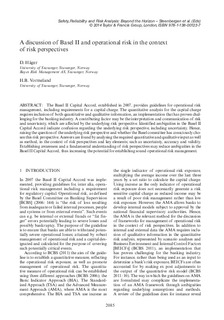| dc.contributor.author | Häger, David | |
| dc.contributor.author | Vormeland, Hilde Brattebø | |
| dc.date.accessioned | 2014-10-30T10:27:35Z | |
| dc.date.available | 2014-10-30T10:27:35Z | |
| dc.date.issued | 2014-03 | |
| dc.identifier.citation | Häger, D. & Vormeland, H. B. (2014) A discussion of Basel II and operational risk in context of risk perspectives. In : Steenbergen et al. (Eds) Safety, reliability and risk analysis : beyond the horizon : proceedings of the European Safety and Reliability Conference, ESREL 2013, Amsterdam, the Netherlands, 29 September-2 October 2013. pp. 453. Boca Raton : Taylor & Francis. | nb_NO |
| dc.identifier.isbn | 978-1-138-00123-7 | |
| dc.identifier.uri | http://hdl.handle.net/11250/225072 | |
| dc.description | Safety, Reliability and Risk Analysis: Beyond the Horizon –Steenbergen et al. (Eds). © 2014 Taylor & Francis Group, London, ISBN 978-1-138-00123-7.
CRC Press / Balkema
Taylor & Francis Group - an informa business | nb_NO |
| dc.description.abstract | The Basel II Capital Accord, established in 2007, provides guidelines on management of operational risk including requirements for regulatory capital. In the quantitative analysis of operational risk the guidelines require an inclusion of both quantitative and qualitative information, an implementation that has proven challenging for the banking industry. The way in which the guidelines are formulated may have contributed to this challenge by generating confusion regarding underlying assumptions and premises of the risk analysis. A review of the guidelines indicates that statistical methods along with sufficient number historical observations are considered to provide an accurate measure of operational risk with limited uncertainty. Subjective input on the other hand, such as scenario analyses and Business Environment and Internal Control Factors, could, according to the guideline, result in increased uncertainty in results. Uncertainty, however, in a risk management context, is closely related to the underlying risk perspective. Even though it is rarely debated in an operational risk setting, there are several different risk perspectives; some which rely on historical observations to provide accurate objective estimates, while others use a broader information basis including expert judgments to explain a phenomenon. The chosen risk perspective impacts the assessment of risk and uncertainty along with the presentation of the analysis results, thus influencing the support for decision-making. Observed inconsistencies in the Basel II Capital Accord raises questions regarding the underlying risk perspective and whether the Basel committee has consciously chosen this risk perspective. In this paper the Basel II guidelines are discussed in the context of different risk perspectives with the aim of providing a foundation for further improvement of the guidelines. A thorough and fundamental understanding of risk perspectives may contribute to clarify the Basel II guidelines to avoid ambiguities and confusion, thus improving the support for establishment of sound management of operational risk. | nb_NO |
| dc.language.iso | eng | nb_NO |
| dc.publisher | Taylor & Francis | nb_NO |
| dc.subject | samfunnssikkerhet | nb_NO |
| dc.subject | safety | nb_NO |
| dc.subject | risk perception | nb_NO |
| dc.subject | risk assessment | nb_NO |
| dc.subject | Basel II | nb_NO |
| dc.subject | banking industry | nb_NO |
| dc.title | A discussion of Basel II and operational risk in context of risk perspectives | nb_NO |
| dc.type | Conference object | nb_NO |
| dc.subject.nsi | VDP::Social science: 200::Economics: 210 | nb_NO |
| dc.source.pagenumber | p. 453 | nb_NO |
